Nolan 51HJ Coaxial Multi-engine Helicopter
Nolan 51HJ Coaxial Pendulum Multi-Engine Helicopter Introduction
Have you ever watched a hummingbird, a butterfly, or a bumblebee – and envied the total freedom they have in flight? Have you ever watched in awe as they darted back and forth, up and down, fast and slow, resting here, going there – the epitome of total freedom in flight. Have you ever though – why not build a Multi-engine Helicopter?
Have you wondered what it would be like to be able to experience the beauty of the earth, unhampered by conventional restrictions, free as the wind. Have you ever experienced how beautiful the earth becomes from 100′ in the air when you have an uninhibited panoramic view moving in slow motion. Did you know that there’s a way to temporarily slip away from the stress, the tragedy, and the turmoil of humanity.
Welcome to the world of the swing-wingers. The closest thing to being born with wings! With the helicopter you get the same view that a person has standing on a mountaintop – except now, in no time at all. you can quickly go down and examine the valley. Rotary-wing flying is three-dimensional flying at its best!
And there are other benefits too. The friendships, the personal challenges, the admiration you receive. and the self-satisfaction that comes from building and mastering a flying machine. The helicopter is the most flexible and maneuverable aircraft in the air. Because of its agility, it has become the workhorse of nearly every major industry in the world.
In the past people have missed out on the opportunity to fly helicopters because of the cost of training, flying, owning, and maintaining one. They’ve been forced to limit their three-dimensional freedom of flight by having to be satisfied with the limited maneuverability of fixed-wing flight. You now have the opportunity to fly with the expression of freedom that only a helicopter can give you. And you can do it in a helicopter that is much easier to fly than the traditional helicopter.
The Nolan 51 HJ helicopter is a single place, twin reciprocal engine, dual coaxial blade, fully maneuverable rotary-wing aircraft. It has been in development for 5 years and has undergone numerous design changes through the building of 4 different prototypes.
To date, the Nolan 51HJ Coaxial Pendulum Multi-engine Helicopter has been test flown to an altitude of 500′ and 50 MPH. The helicopter fly’s relatively easy out of ground effect, and a great deal of flight testing has been conducted within ground effect in an effort to fine tune the handling characteristics throughout this more sensitive area of flight.
The Nolan 51HJ helicopter can be built in less than 400 hours with basic hand tools. The kit will be produced with the fuselage framework completely welded and the major components completely assembled. This is done to assure maximum safety in the critical areas.
Nolan Coaxial Helicopter Redundant Systems
| Unique Helicopter Design | |
|---|---|
|
|
Nolan Coaxial Helicopter Design
When the Nolan brothers started out. they wanted to design a helicopter that was cheaper, safer and simpler to operate and maintain. It had to be both dependable and durable.
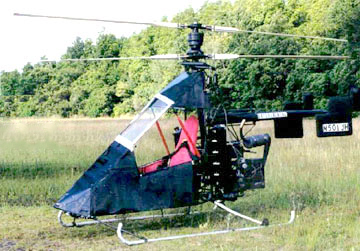
They realized that there were a lot of people that might buy a helicopter if they could afford it, and also be able to maintain it! The ability to own, fly and maintain an aircraft inexpensively is the key to the real enjoyment of a sport or experimental aircraft.
To achieve low cost they reduced the number of operating systems required to fly the helicopter. They used basic construction techniques and only the things absolutely necessary for flight are included on it.
To achieve simplicity they eliminated major components and sophisticated mechanical linkages such as the tail rotor, the tail rotor drive shaft and gearbox, the tail rotor pitch linkages, the collective pitch controls and pitch links, the pitch horns, rotor bearings, the cyclic controls and swash plate. To achieve safety they built redundancy into every major component where practical.
There are two engines, two electrical systems, two belt drives, two drive pulleys, two rotors, and two fuel tanks. The pilots cockpit is a welded and padded steel compartment with 3-inch lap belts and shoulder harnesses. The pre-welded frame of the aircraft consists of 4130 chromium-molybdenum alloy steel.
To achieve durability they utilized heavy duty components that reduce the need for replacement, or high-cost maintenance. They’re trying to build everything on the aircraft with a high TBO. In order to achieve this, the Nolan brothers had to start with a completely new design and built their helicopter from scratch.
The present model has a twin coaxial rotor system which cancels torque, a belt driven transmission, a simple twin rudder which provides yaw control, twin throttles which control climb and descent, fixed pitch rotor blades which rotate on a gimbal system, and win engines. This project has taken more than 5 years and thousands of dollars to develop, and they’re on their fourth prototype.
Jack Nolan has over 60 hours flying the different prototypes (tethered & free-flight), and he continues his test fling because he doesn’t want to present a weak, untested product to the end user.
Nolan Coaxial Helicopter Aircraft Systems
Because the coaxial pendulum helicopter has such a simplicity of design to it. people constantly wonder why nobody has ever done this before. The answer is just as simple. The key to the success of the coaxial pendulum helicopter is in the marrying of its different systems. Nobody has ever put the systems together quite like the Nolan brothers have.
The Nolan brothers had a strong background in automotive racing. They were accustomed to looking at problems that involved time, space, physics & mechanics, and coming up with solutions that solved the requirements of all four elements – and doing it in a manner that continued to afford maximum protection of the driver.
They simply transferred their experience to the realm of rotary-wing flight. The whole aircraft is a combination of strong, redundant, simple solutions to ordinary problems in the rotary-wing arena.
Nolan Coaxial Helicopter Rotor system
The coaxial bladed rotor system solves all of the problems that the tail rotor offers. By removing the tail rotor, you no longer have to worry about tail rotor strikes, injuries or failures. You also remove a fair portion of the helicopters complexity and maintenance requirements.
Another advantage to the coaxial system is that the dual blades allow you to maintain a high disc loading without the need for a huge rotor diameter. This reduces the opportunity for blade strikes, and injuries while near the ground. It also makes the aircraft easier to store or park in confined spaces.
The coaxial rotor system also removes the problem of torque. In a coaxial rotor helicopter if you lose the entire tail of the aircraft, the helicopter will still fly and remain under control because the counter-rotating blades cancel out the torque for each other. There is no tendency to experience ground resonance when landing or air taxiing with the coaxial system.
Nolan Coaxial Helicopter Rudder Controls
The Nolan 51HJ Coaxial Pendulum Multi-engine Helicopter has two different types of rudders. There is a small set of vertical rudders that facilitate horizontal control while in forward flight. Then there is a set of downwash rudders that facilitate horizontal control while hovering. Both rudders combined cause the aircraft to be extremely stable in forward flight.
You have constant control about the horizontal axis of the aircraft because the downwash is a constant source of energy working in conjunction with the twin sets of rudders. Drive Shaft, Transmission and Clutch System All critical components, like the drive shaft and transmission, are built to standards that far exceed the needs of the aircraft.
The drive shaft is built to be utilized continuously for thousands of hours on a vehicle with a gross weight of over 3,000 pounds. The gross weight of the helicopter is under a thousand pounds and the aircralt will be operated with far fewer hours of continuous use. The transmission system is a unique design perfected by the Nolan brothers for use in this type of helicopter. The transmission is built to handle greater stresses than the aircraft can place on it.
Engineers of the typical coaxial helicopter had the problem of the advancing and retreating blades contacting each other because in full advance and retreat one blade is lower while the other blade is higher. The Nolan brothers solved this problem by designing the transmission so that it only allows the blades to pass over each other when they are approximately 45″ away from full advance or retreat. During the time when the two blades are at their highest and lowest height, they are nowhere near each other.
The clutch system is a sprague clutch type system that automatically disengages if an engine quits in the multi-engine helicopter. Each clutch system is totally independent of the other. The belt drive was used because it turned out to be more stable and less problematic than other systems that the Nolan brothers tried. The belts are heavy duty and oversized for ruggedness and safety.
Nolan Coaxial Multi-engine Helicopter Hydraulic Control System
The hydraulic control system is a close-looped system. It doesn’t require a hydraulic pump to operate it, and it is built to handle 400 PSI. The aircraft controls only utilizes about 4 PSI. The hydraulic system gives you smoother control and it eliminates the problems associated with cable stretching, fraying, and breaking. Brass fittings are used to eliminate the problems commonly found with aluminum fittings in aircraft hydraulics.
Retention straps on the rudder pedals will allow the pilot to maintain push-pull control with one foot if one of the control pedals becomes damaged. The sensitivity of the control stick is adjustable for varying levels of experience. The pitch and roll hydraulic controls are totally independent from the horizontal hydraulic controls.
Nolan Coaxial Helicopter Pilot Compartment
The pilot compartment does not have any sharp edges or protrusions. Key areas within the compartment are padded. The seat utilizes 3″ lap belts and shoulder harnesses with industrial connectors. In event of a crash, the areas around the compartment are designed to absorb and reduce the energy ot the crash before it reaches the pilot.
Retention straps have been added to the rudder pedals to help prevent impact of the legs with the steel tubing in the event of an incident. The steel cage surrounding the pilot provides roll-over protection and it reduces the opportunity for the pilot to be injured in event of a bird, wire or tree branch strike.
Nolan Coaxial Helicopter Engine System
The Rotax 503 engines are mounted vertically. They have electric starting capability, dual carburetors and CDI ignition. The blowers on the engines provide air cooling from one direction while the rotor downwash provides cooling from the other direction. This eliminates the need for water cooling. The engine compartment unbolts for quick access or removal of the dual engines.
Because the engines are mounted in the opposite direction from each other, the muffler on the left engine is vented away from the pilot so that the doesn’t suffer excessive noise, or breath exhaust fumes during slow speed maneuvers or hovering. Each engine is totally independent from the other engine.
Nolan Coaxial Multi-engine Helicopter Safety
Safety was one of the strongest areas that the Nolan brothers focused on as they designed and built this aircraft. They had spent a lot of time racing cars and they knew the value of building a crash survivable vehicle. They used two primary strategies to increase pilot safety and survivability in this aircraft. First they focused on the prevention of an incident, and then they focused on the survivability of an incident.
To help prevent the incident, they built redundancy into the major systems of the entire aircraft. To ensure survivability, they included protective items such as a 4-point seatbelt, an enclosed pilot cage (which helps to provide pilot protection in the event of an inflight strike of limbs, wires, and birds), and they also padded the cockpit area.
The effectiveness of their efforts in this area has already been proven. Both brothers have tipped the aircraft over in landing accidents as they tried to teach themselves to fly this type of helicopter (they couldn’t take regular helicopter lessons because their helicopter isn’t controlled like a typical helicopter). These accidents are one of the reasons why they’re on their fourth prototype.
Both accidents occurred without injury. Their initial wooden rotor blades shredded (they now use aluminum blades) and the tail surfaces were destroyed. Nothing else was affected. The aircraft tipped over both times due to pilot error (Pilot error is a natural outcome of self-taught flying). The pilots suffered no bruises, aches, pains, or even any scratches!
They had the major components magnafluxed after each incident and there were no stress cracks or additional damage of any kind. Talk about structural integrity! One of their biggest safety factors of the Nolan 51 HJ helicopter is its ability to eliminate the need for autorotation. Autorotation is an emergency maneuver which must occur in a matter of seconds alter the engine quits in a typical helicopter.
It requires precise skills to accomplish effectively. Because of the high rate of descent and need for precise timing, a large number of accidents in the rotary-wing field occur during the practice of autorotations. If you ever want to give your passenger an “E”-tickle ride comparable to anything that Disney World has to offer, try doing a few full-stop autorotations with them.
The twin-engine capability of the Nolan 51HJ Coaxial Pendulum Multi-engine Helicopter eliminates having to do an autorotation. If One engine quits, you simply continue living under full power and control until you find a suitable place to land. If your engine quits while you’re over trees, jagged rocks, or water – you no longer have to autorotate into them. With the Nolan 51 HJ helicopter, you just fly on until the landing site becomes more suitable and safe.
Nolan Coaxial Helicopter Comparison Chart
The following depicts the differences between the typical single rotor helicopter and the coaxial pendulum helicopter (CPH):
| Component | Purpose | Typical Helicopter | Nolan – CPH |
|---|---|---|---|
| Tail rotor svstem | Yaw control – Anti-torque | Tail rotor – Gearbox – Pitch linkages – Drive shaft | None needed – Twin rudders – No torque |
| Cyclic system | Pitch & Roll | Swash plates – Rod ends – Counter balances | None needed – Simple gimbal |
| Collective system | Altitude control | Collective stick – Pitch links – Pitch horn | None needed – Throttles used |
| Engine | Provide power | Single engine | Twin engines |
| Throttle | Maintain rotor RPM Speed | 1 only | 2 each – simultaneous or independent |
| Autorotation | Emergency maneuver | High risk activity | Eliminated activity – Flys on one engine |
| Control movement | Coordinated flight | Sensitive, constant 4-input coordination | Basic stick, rudder & throttle coordination |
Nolan Coaxial Helicopter Eliminated Components
The following list of items represent different components that may be found on a typical helicopter. These components have all been eliminated on the Nolan 51HJ multi-engine helicopter. This represents a tremendous savings in gross weight, mechanical complexity, and cost of replacement. It also reduces the opportunity for component failure while inflight, personal injury while on the ground, and the need for maintenance.
| Nolan Coaxial Helicopter Eliminated Components | |
|---|---|
| Tail rotor drive shaft | Tail rotor drive shaft bearings |
| Tail rotor blades | Tail rotor gearbox |
| Swash plate | Stabilizer bar |
| Tail Rotor Annunciators | Spindles |
| Multiple push-pull tubes | Pitch control arms |
| Cyclic pitch lever | Collective pitch lever |
| Collective stick | Pitch horns |
| Hydraulic rotor brake | Blade torsional bearing housing |
| Blade feathering mechanism | Takeoff gear drive |
| Intermediate gearbox | Blade dampers |
| Tail rotor head | Couplings |
| Lead/Lag hinges | Tail rotor guard |
| Feathering mechanism | Cabl e assemblies |
Nolan Coaxial Helicopter Flight Maneuvers
Flying the Nolan 51HJ helicopter is similar to riding a bicycle. Once you have become practiced enough to know what controls to move to maintain your balance, maintaining your balance becomes a natural activity. Once you have developed this “sense of balance”, as various forces affect your flight attitude, you just naturally counter them with your controls.
Pretty soon you are able to do just about anything you want with the aircraft. Most people are good at riding their bicycle in a normal manner. Others can do some pretty amazing maneuvers with it. The same is true of the coaxial pendulum helicopter. The skill level is simply a matter of practice. The more you practice, the more your reactions become natural, and the more enjoyable and expert your flying becomes.
Emergency engine-out procedures are pretty simple. You just push both throttles full forward. Unlike some of the fixed-wing aircraft, there is no need to determine which engine is out before taking action, and there is no unbalanced thrust to counteract. Losing an engine in the coaxial pendulum helicopter is a non-emergency because it will fly on one engine.
Another distinct advantage about the Nolan 51HJ Coaxial Pendulum Multi-engine Helicopter is the fact that the enclosed pilots cage gives you a sense of security in flight that you don’t receive while flying many of the other homebuilt designs. You get the advantage of total visibility without the insecure feeling that you’re sitting on the edge of a very small chair too high in the air.
If you ever do have an occasion where you lose an engine, as a safety precaution, we recommend that you immediately descend to the lowest safe altitude and find a safe place to land. Continued flight on a single engine is not recommended because you no longer have the safety factor of a back-up engine. Our test pilot has publicly demonstrated the following flight maneuvers with the Nolan 51 HJ helicopter.
| Nolan Coaxial Helicopter Flight Maneuvers | |
|---|---|
| Hovering in ground effect | Hovering out of ground effect |
| Hovering turns about a point | Hovering pedal turns |
| Sideways flight – right & left | Backward flight |
| Rearward climbing reversal turn from a hover | Vertical takeoff |
| Vertical landing | S-turns through a slalom |
| Figure-eight turns | Quick stops |
| Vertical take-off to a hover | Climbing turns |
| Descending turns | Air taxiing |
| Normal take-off, climb, flight, descent & landing | Single engine flight |
| Flights in confined areas | 180 ° reversal turns from forward flight |
Nolan Coaxial Helicopter Parts & Accessories
The following parts will be supplied with each aircraft kit. The kit may be purchased as a total package, or by separate sub-assembly.
Airframe Kit
-
Airframe welded
-
Skid system
-
Downwash rudder system
-
Rudder control system
-
Auxiliary wheels
-
Engine mounts
-
Tail boom assembly
-
Protective padding
-
Padded seat assembly
-
4-point seatbelt assembly
Pitch & Roll Control Kit
-
Control stick with hydraulic assembly
-
Control head with link assembly
-
Rotor head assembly
Transmission & Fuel system
-
Throttle quadrant assembly
-
Instrument panel
-
Switches – Starter, dual
-
Fuel tank assembly, dual
-
Fuel tank drain, dual
-
Electrical system, prewired
-
Transmission gear-shaft assembly
-
Pulley & Belt assembly, dual
-
Protective engine skid
Rotor Blade System
-
Rotor blades, prefinished (4)
-
Rotor Hub
Specifications of the Nolan 51HJ Coaxial Pendulum Multi-engine Helicopter
| Airframe | |
|---|---|
| Type | Single place coaxial pendulum helicopter |
| Engines | 2 Rotax 503’s rated at 100 HP total |
| Pilot weight – max | 260 Lbs with full fuel |
| Baggage (lbs) | There is currently no specialized storage space for baggage |
| Gross weight | 800 Lbs |
| Empty weight | 480 Lbs |
| Useful load | 320 Lbs |
| Fuel | 2 Five Gallon tanks |
| Rotor blades | 4 Aluminum symmetrical blades |
| Rotor Diameter | 13.58 ft |
| Rotor RPM | 857 |
| Disk area (sq ft) | 144.76 |
| Disk area (coaxial) | 289.52 |
| Disk loading | 2.76 |
| Length (with rotors) | 14.25 ft |
| Length (without rotors) | 13 ft |
| Height | 8 ft |
| Width | 5 ft 6 inches |
VIDEO: Early video of the Nolan Brothers coaxial helicopter
| Flight Performance | |
|---|---|
| Range | N/A |
| Flying time | Minimum of 1 hr at hovering RPM |
| Hover IGE | N/A |
| Hover OGE | N/A |
| Cruise | 60 MPH |
| Max speed | Estimated at 80 MPH |
| VNE | N/A |
| Service Ceiling | N/A |
| Translational lift | 8-10 MPH |
EDITORS NOTE: As with any invention, there are pro’s and con’s to their outcomes. The Nolan Coaxial Helicopter certainly simplified the whole “rotary wing” flight concept, but with it’s many positives – there was a few serious negatives. One being there was no ability to change the blade pitch which means any sort of an autorotation from a complete power failure was completely out of the question. To counter this, two independent engine systems are run – with that comes extra weight, extra noise and extra fuel consumption. For use as a low level motorcycle of the air…it suited its purpose, as should both engines fail, the sound roll cage would enable a high survivability rate at low altitude.
PLEASE NOTE: Nolan Brothers sold on the helicopter to Eagle’s Perch marketing before it reappeared as the SkyBlazer. Currently there is no known active manufacturer of this design. A Google search may on occasion show different companies promoting this design. There are also a few copies of the design flying around Asia – search YouTube: “coaxial helicopter”.



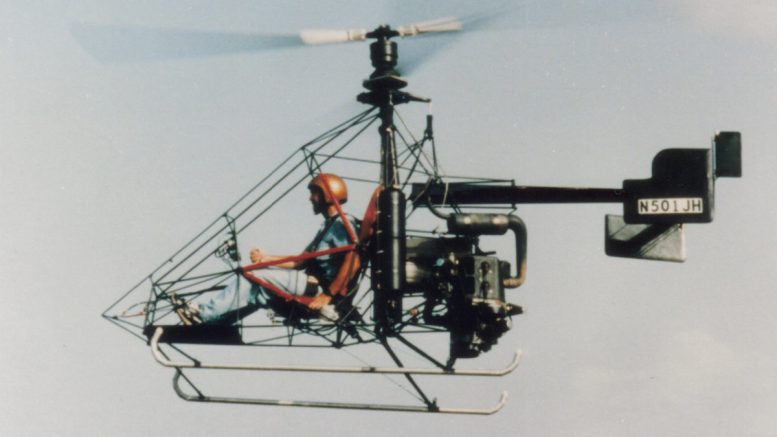
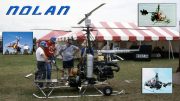
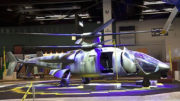
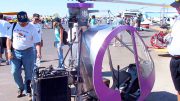
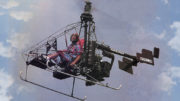
Be the first to comment on "Nolan 51HJ Coaxial Pendulum Multi-engine Helicopter"